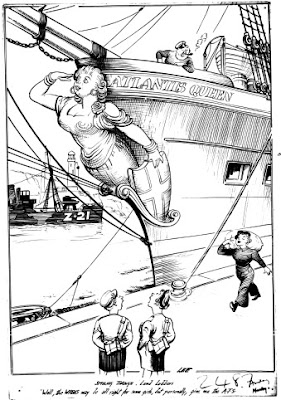It's the way she handles her pipe and acts like a jaunty Jack Tar - even when pregnant - that gets me. And the fact that male seafarers loved it.
Yes, female impersonator Hetty King could offer men that longed-for goodie: a glimpse into how others see us. She could also suggest that human beings have the potential to be far more than heteronormative.Hetty sang and posed back, doing what thousands of seafaring men had done: take on the appearance of someone belonging to a category from which they were excluded.
In the RN and MN it was unremarkable for men to dress as women, usually as glam stars, especially in ships' shows and in wartime.
Les Girls, Men in Skirts, and The Kiwis are the main examples of iconic all-male touring shows in and after WW2. Usually the outrageousness (even illegaility) was sidestepped by humour.
WHY DID SEAMEN CROSS-DRESS?
Putting on skirts - metaphorically over the workaday bell-bottoms - was a way for men to:
- entertain shipmates
- express their 'feminine' aspects
- explore heteronormativity
- attract same-sex lovers
- raise awareness that there was a gay community
- implicitly make the point that gender is performed.
WHO WAS HETTY?
This music hall star born Winifred Emms (1883-1972) was a professional male impersonator who specialised in soldiers, swells and navvies as well as Royal Navy ratings and officers.
She's most famous for being the first person to perform 'Ship Ahoy. All the Nice girls Love a Sailor' (in 1908).
For her career she travelled a lot on ships e.g. in 1907 - to New York. It may have been on board merchant vessels that she observed MN seafaring men and thereby became adept at copying their style.
Here are three ways that Hetty behaved differently to cross-dressing seafaring males:
- She worked on stage on land, professionally. Not in a vessel-based workplace in the intervals of doing her proper job
- She wasn't - seemingly - exploring her sexuality and gender. Not a lesbian, she was married to men (Ernie Lotinga, 1901-1917) and Alexander Lamond (1918)-?); had at least one affair with a man (Jack Norworth); and was pregnant at least once (in 1913)
- She wasn't dressing for members of her own sex, in complex alliance with them. She was doing it for the very men she was taking off. And they liked it.
Many young women in WW1 posed in sailor clothes for the camera, especially if they had boyfriends who were seafarers. It appears to be an act of affinity and bold fun. It may also have expressed women's desire to live a sea life.
SO WHY DID MEN LIKE THIS WOMAN 'BEING' THEM?
Men's enthusiasm for Hetty's shows hasn't been discussed yet, to my knowledge.
But from my research into gender and seafaring, I believe the following reasons explain why sailors liked watching her 'be them':
- She was holding up a mirror, a flattering mirror
- It was an emotionally satisfying way of getting attention and being accompanied, known
- She wasn't trying to steal their power or be snide
- It was an ersatz way of being on stage yourself, a vicarious and safe thrill.
Pictured left. Seafaring women pursers in the 1970s MN dress up to sing All the Nice Girls Love a Sailor in an on-board show on a cruise ship.
Women in the MN and RN today wear trousers. but sometimes skirts. Men do not have that option, except in off-duty play.
LEARNING MORE
There's footage of Hetty King on YouTube, including an interview in 1970 where she makes up in a dressing room.








No comments:
Post a Comment